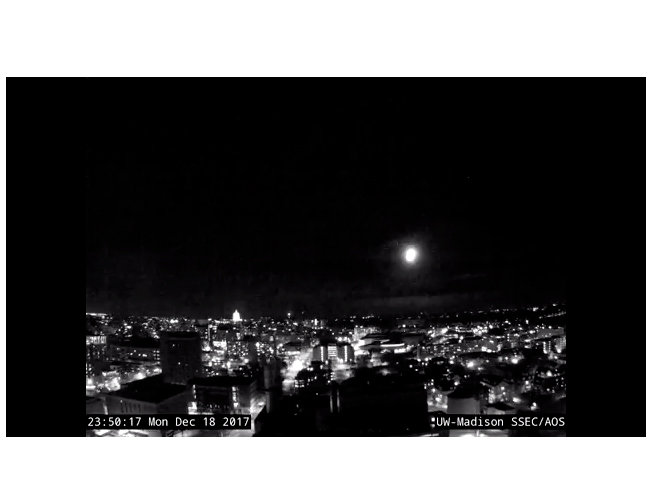The weather becomes newsworthy during times of natural disasters. Whether its flooding, hurricanes or tornados, when peoples' lives are in jeopardy, or their town gets wiped out, that becomes a legitimate news story. When it's of local significance, it certainly deserves to trump the latest pre-season Packers story on the four Milwaukee stations that produce newscasts. Similarly, severe weather bulletins (but not a "severe thunderstorm watch") have every right to dominate coverage if they could potentially save lives.
But the ongoing, repetitive and exhaustively comprehensive coverage of daily weather on local TV news has become such a throw-back waste of time, I'm losing my patience a little more each and every night.
You may have read my rants about the decreasing amount of real reporting in what 4, 6, 12 and 58 call the news. I've rolled my eyes for every investigative story on the "male Brazilian wax thief" on WTMJ-4, or the no-less-than 100 mentions per cast of the WITI-6 Web site (hey, FOX6, if you want me to visit your site so badly, maybe you should move away some of the shameless self-promotion house ads and put some local news within the first 1,000 pixels from the top of my screen).
But what really gets my goat is the minutes upon minutes per half hour cast, devoted to weather -- local and national -- that could probably be accomplished in the form of a crawl at the bottom of the screen throughout the entire show.
You know what I'm talking about. Monologues that approach a high school science class in detail, showing the position of fronts, directions of clouds, dew points and relative humidity. That's great, but it's much more detail than I need. The warm front over New Mexico doesn't really interest me, and if it does, trust me -- I'll find it elsewhere.
Here's what I want: What's the temperature now? What will it be like later today? What will it be like this week? Should I expect rain, snow or sun. I'd even accept an admission that meteorologists can't accurately predict the forecast seven days in advance, so here is the next 72 hours, and we promise it's accurate.
That basic information (as well as the meteorological cornucopia of info blasted to me every night) is available everywhere I look. Online, on my cell phone, on cable weather channels, in the newspaper -- even on the marquee of the bank and atop the Wisconsin Gas Building ("When the flame is red, it's warm weather ahead, etc."), it's not hard to find. Why then, should I look to local TV to fill me in on the rain totals in Slinger?
Let me say it again: I don't need 10 minutes of weather theory every night. Tighten it up and give me some local news. Not Iraq updates, not repackaged video news releases from your network and not "America Idol" coverage. Whether it's "live from the newsroom" or out in the field, I don't need this much fluff.
I asked one source in the industry, who says the weather segments comprise only three minutes per cast, which is slightly longer than the sports news. That seems a little light to this casual observer.
A recent study by the American Association of Advertising Agencies (AAAA) and the Association of National Advertisers, Inc. (ANA) showed that local news broadcasts 19:06 minutes of ads per hour. Split that in half, and you have about 20.5 minutes of "news" per half-hour cast. I haven't sat in front of the TV with a stop watch, but I estimate that weather comprises at least six minutes per broadcast, when you include all the "weather first" segments and weather babbling at the end of each show.
By my math, that's 29 percent of the local news devoted to run-of-the-mill weather. That's a lot of El Nino.
About 10 years ago, Bill Gates said that the Internet will never replace the yellow pages, and people will never use the Web to simply search out a phone number. At the time, when I surfed Netscape 2.0 my 28.8k modem, I actually agreed. Now, however, that's probably one of the most laughable statements ever uttered about modern Internet usage.
I'm sure the folks who bring you Milwaukee local news provide a deluge of weather for two reasons: it sells ads, and people watch it.
But perhaps that's changing. Check out this 2006 study from Crawford Johnson & Northcott Inc. They interviewed a sample group between the ages of 18 and 64 and found out several interesting media usage tendencies. The ones that are relevant for this discussion include:
- Eighty-five percent are very of somewhat likely to seek out local weather information on the Web.
- Twenty-six percent said they would go to a local television Web site for local weather; 9 percent would go to a local newspaper site; 13 percent to a national news site (such as CNN or FOX News); and 40 percent said they would go to some "other site."
Not sure why the survey didn't include (wait for it) weather sites or portal sites like Yahoo or Google, but I think it's safe to assume that most of that 40 percent is getting their weather info there.
People's media tendencies are changing, and it's interesting to watch Milwaukee's local TV news cling to a formulaic dinosaur that probably made great sense in, oh, about 1960. I'm not ready to tune out local TV news yet, and I know several people in the industry who take their jobs and journalistic integrity very seriously.
But if Milwaukee's local news continues to broadcast increasingly irrelevant content, I'm going to keep changing the channel. And my guess is that I'm not alone.
Andy is the president, publisher and founder of OnMilwaukee. He returned to Milwaukee in 1996 after living on the East Coast for nine years, where he wrote for The Dallas Morning News Washington Bureau and worked in the White House Office of Communications. He was also Associate Editor of The GW Hatchet, his college newspaper at The George Washington University.
Before launching OnMilwaukee.com in 1998 at age 23, he worked in public relations for two Milwaukee firms, most of the time daydreaming about starting his own publication.
Hobbies include running when he finds the time, fixing the rust on his '75 MGB, mowing the lawn at his cottage in the Northwoods, and making an annual pilgrimage to Phoenix for Brewers Spring Training.







